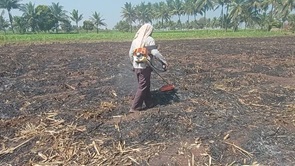Ratoon Management Practices
Ratoon plays a very important role in economizing the cost of sugarcane production, through saving in the cost of preparatory cultivation, seed material and planting expenses. The productivity of sugarcane in Bihar is lowest among the major cane growing states of India due to syndrome of factors. Among them one of the major reasons is poor yield of ratoon cane although in this state it occupies about 50 % of the total cane area. It has been evidently proved that if ratoons are managed well they yield at par with that of plant cane. After reviewing the research works on ratooning following package of practices are recommended for multiple ratooning.
1. Variety:
Success and failure of a sugarcane variety is depends on its ratooning ability. Though, most of the present day varieties have good ratooning ability.
2. Time of ratoon initiation:
Harvest of plant crops during the month of February to March would give best ratoons.
3. Method of harvest:
Harvesting of plant crop close to the ground level is must to get a better ratoon crop
4. Stubble shaving:
After harvest of plant crop, an important operation that has been to be carried out is stubble shaving. This is done to facilitate sprouting of underground buds with a deeper root system. This can be done from 4 to 5 cm below the ground.
5. Dismantling of ridges:
It is an operation where in the ridges formed due to earthing-up are broken or cut on either side to loosen the soil which facilitate better aeration.
6. Gap filling:
Optimum viable clumps are essential to obtain good ratoon crop. Results of research indicates that 27000 to 33000 viable clumps/hectare or 3 viable clumps/metre row length is necessary to obtain economic returns. If the population of viable clumps less than that, gap filling with the pre-germinated buds of same variety may be done on priority basis.
7.Soil and ratoon treatment:
Apply carbendazim @ 0.1% just after stubble shaving for protection from set borne diseases. For soil treatment fipronil 0.3 GR @ 25 kg/ha should be applied after 3 weeks of stubble shaving.
Manure and fertilizer:
FYM or compost @ 20 tonnes/ha should be sprade after dismantling of ridges. Chemical fertilizer in ratoon crop should be applied as below.
|
Fertilizer application in ratoon crop (kg/ha) |
|||
|
Time |
N |
P2O 5 |
K2O |
|
3 weeks after stubble shaving |
80 |
50 |
60 |
|
7 - 8 weeks after stubble shaving |
45 |
- |
- |
|
At the time of earthing-up |
45 |
- |
- |
|
Total |
170 |
50 |
60 |
Irrigation: Before monsoon at least 5 irrigation should be given
Earthing-up: As plant crop, earthing-up should be done in the last week of June. At the time of earthing-up left over 25 % N along with carbofuran 3G @ 33 kg/ha should also be applied.
Propping: As plant crop, propping may be done in the month of August – September.
Low cost technology:
Due to increase in labour and input cost, the cost of cultivation of sugarcane is very high. It can be reduced by following appropriate technology:
1. Use of bio-fertilizers
2. Use of crop residues
3. Green manuring
4. Slow release fertilizer
5. Foliar feeding of nutrients
6. Soil testing
7. Use of herbicides



